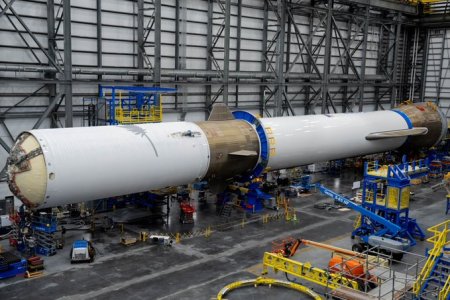Blue Origin’s Blue Ring orbital tug gets a customer
Blue Origin today announced that the orbital situational awareness company Optimum Technologies (OpTech) has purchased payload space on the first flight of its Blue Ring orbital tug.
Blue Ring’s first mission is expected to launch in 2026 with initial injection into Geostationary Transfer Orbit (GTO) and additional services performed in Geostationary Orbit (GEO). The Blue Ring vehicle will demonstrate its ability to simultaneously support the GEO tracking and custody mission as well as space object characterization, leveraging dynamic maneuverability to support high-resolution characterization.
OpTech’s Caracal sensor is designed to provide actionable insights on resident space objects and orbital activity and includes onboard image storage, object detection algorithms, and passive thermal control. The payload is designed to operate flexibly across dynamic orbits over a year-long mission profile. Caracal will fly with Scout Space’s Owl sensor, along with internally developed payloads, all demonstrating Blue Ring as the ideal platform for supporting future GEO space domain awareness missions.
This instrument is designed to inspect what else is in orbit. It could be that the mission will have Blue Ring fly close to other satellites, both foreign and domestic, so that Caracal can gather imagery and data. Such capabilities are things both the Chinese and Russians have tested repeatedly and the Pentagon needs as well.
This announcement once again indicates that under CEO David Limp, Blue Origin is finally beginning to actually do things.
Blue Origin today announced that the orbital situational awareness company Optimum Technologies (OpTech) has purchased payload space on the first flight of its Blue Ring orbital tug.
Blue Ring’s first mission is expected to launch in 2026 with initial injection into Geostationary Transfer Orbit (GTO) and additional services performed in Geostationary Orbit (GEO). The Blue Ring vehicle will demonstrate its ability to simultaneously support the GEO tracking and custody mission as well as space object characterization, leveraging dynamic maneuverability to support high-resolution characterization.
OpTech’s Caracal sensor is designed to provide actionable insights on resident space objects and orbital activity and includes onboard image storage, object detection algorithms, and passive thermal control. The payload is designed to operate flexibly across dynamic orbits over a year-long mission profile. Caracal will fly with Scout Space’s Owl sensor, along with internally developed payloads, all demonstrating Blue Ring as the ideal platform for supporting future GEO space domain awareness missions.
This instrument is designed to inspect what else is in orbit. It could be that the mission will have Blue Ring fly close to other satellites, both foreign and domestic, so that Caracal can gather imagery and data. Such capabilities are things both the Chinese and Russians have tested repeatedly and the Pentagon needs as well.
This announcement once again indicates that under CEO David Limp, Blue Origin is finally beginning to actually do things.

